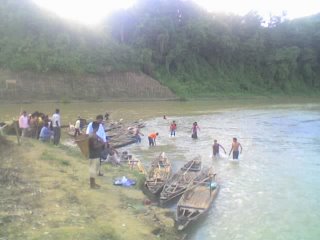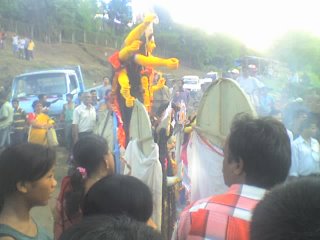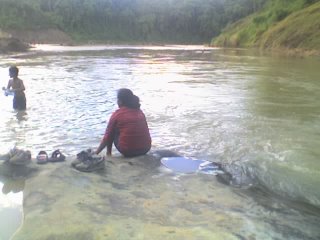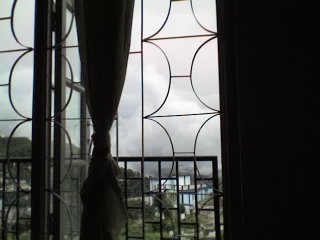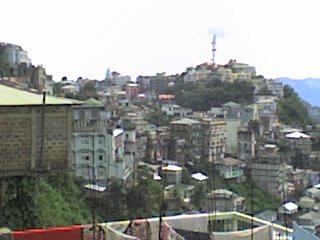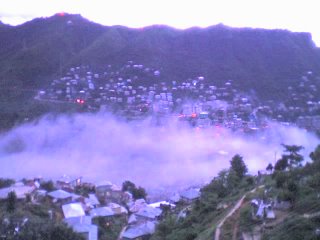
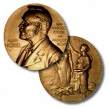
This is taken from an email forwarded to me. I have no idea who the author is or in which publication it first appeared. I do appreciate the rationality expressed, yet I cannot help feeling that an East-West divide is being highlighted, and that too quite slyly. Read on, and perhaps you will arrive at your own conclusions.
-------
MICROCREDIT, MACRO ISSUES
by Walden Bello
The awarding of the Nobel Peace Prize to Muhammad Yunus, regarded as the father of microcredit, comes at a time when microcredit has become something like a religion to many of the powerful, rich and famous. Hillary Clinton regularly speaks about going to Bangladesh, Yunus's homeland, and being "inspired by the power of these loans to enable even the poorest of women to start businesses,lifting their families--and their communities--out of poverty."
Like the liberal Clinton, the neocon Paul Wolfowitz,now president of the World Bank, has also gotten religion, after a recent trip to the Indian state of Andhra Pradesh. With the fervor of the convert, he talks about the "transforming power" of microfinance: "I thought maybe this was just one successful project in one village, but then I went to the next village and it was the same story. That evening, I met with more than a hundred women leaders from self-help groups, and I realized this program was opening opportunities for poor women and their families in an entire state of 75 million people."
There is no doubt that Yunus, a Bangladeshi economist, came up with a winning idea that has transformed the lives of many millions of poor women, and perhaps for that alone, he deserves the Nobel Prize. But Yunus--at least the young Yunus, who did not have the support of global institutions when he started out--did not see his Grameen Bank as a panacea. Others, like the World Bank and the United Nations, elevated it to that status (and, some say, convinced Yunus it was a panacea), and microcredit is now presented as a relatively painless approach to development. Through its dynamics of collective responsibility for repayment by a group of women borrowers, microcredit has indeed allowed many poor women to roll back pervasive poverty. However, it is mainly the moderately poor rather than the very poor who benefit, and not very many can claim they have permanently left the instability of poverty.
Likewise, not many would claim that the degree of self-sufficiency and the ability to send children to school afforded by microcredit are indicators of their graduating to middle-class prosperity. As economic journalist Gina Neff notes, "after 8 years of borrowing, 55% of Grameen households still aren't able to meet their basic nutritional needs--so many women are using their loans to buy food rather than invest in business."
Indeed, one of those who have thoroughly studied the phenomenon, Thomas Dichter, says that the idea that microfinance allows its recipients to graduate from poverty to entrepreneurship is inflated. He sketches out the dynamics of microcredit: "It emerges that the clients with the most experience got started using their own resources, and though they have not progressed very far--they cannot because the market is just too limited--they have enough turnover to keep buying and selling, and probably would have with or without the microcredit. For them the loans are often diverted to consumption since they can use the relatively large lump sum of the loan, a luxury they do not come by in their daily turnover." He concludes: "Definitely, microcredit has not done what the majority of microcredit enthusiasts claim it can do--function as capital aimed at increasing the returns to a business activity." And so the great microcredit paradox that, as Dichter puts it, "the poorest people can do little productive with the credit, and the ones who can do the most with it are those who don't really need microcredit, but larger amounts with different (often longer) credit terms."
In other words, microcredit is a great tool as a survival strategy, but it is not the key to development, which involves not only massive capital-intensive, state-directed investments to build industries but also an assault on the structures of inequality such as concentrated land ownership that systematically deprive the poor of resources to escape poverty. Microcredit schemes end up coexisting with these entrenched structures, serving as a safety net for people excluded and marginalized by them, but not transforming them.
No, Paul Wolfowitz, microcredit is not the key to ending poverty among the 75 million people in Andhra Pradesh. Dream on.
Perhaps one of the reasons there is such enthusiasm for microcredit in establishment circles these days is that it is a market-based mechanism that has enjoyed some success where other market-based programs have crashed. Structural-adjustment programs promoting trade liberalization, deregulation and privatization have brought greater poverty and inequality to most parts of the developing world over the last quarter century, and have made economic stagnation a permanent condition. Many of the same institutions that pushed and are continuing to push these failed macro programs (sometimes under new labels like "Poverty Reduction Strategy Papers"), like the World Bank, are often the same institutions pushing microcredit programs.
Viewed broadly, microcredit can be seen as the safety net for millions of people destabilized by the large-scale macro-failures engendered by structural adjustment. There have been gains in poverty reduction in a few places--like China, where, contrary to the myth, state-directed macro policies,not microcredit, have been central to lifting an estimated 120 million Chinese from poverty.
So probably the best way we can honor Muhammad Yunus is to say, Yes, he deserves the Nobel Prize for helping so many women cope with poverty. His boosters discredit this great honor and engage in hyperbole when they claim he has invented a new compassionate form of capitalism--social capitalism, or "social entrepreneurship"--that will be the magic bullet to end poverty and promote development.
----------------
The following is selected text from a telephonic interview that Adam Smith from the Nobel Foundation website had with Mohammad Yunus:
[AS] – Is there any particular message you would like to use the opportunity to get across?
[MY] – The one message that we are trying to promote all the time, that poverty in the world is an artificial creation. It doesn't belong to human civilization, and we can change that, we can make people come out of poverty and have the real state of affairs. So the only thing we have to do is to redesign our institutions and policies, and there will be no people who will be suffering from poverty. So I would hope that this award will make this message heard many times, and in a kind of forceful way, so that people start believing that we can create a poverty-free world. That's what I would like to do.
[AS] – Does your work with the Grameen Bank over the last three decades make you more hopeful that this is possible?
[MY] – Oh yes, very much, we see the demonstration of it every day. People come out of poverty every day. So it's right in front of us what happens and it can be done globally, it can be done more forcefully, we can organize more things to go with it, so this is something not theoretical issue, it's a very real issue. People can change their own lives, provided they have the right kind of institutional support. They're not asking for charity, charity is no solution to poverty. Poverty is the creation of opportunities like everybody else has, not the poor people, so bring them to the poor people, so that they can change their lives. That's all we are doing. We didn't do anything special; lend money to the people so – but they never lent it to the poor people – all we did was we lent it to the poor people, and that makes the trick. That makes the change.
-------------
But of course! We live right next door to B'desh, and as far as Calcutta goes, we live in each other's pockets! Microfinance has been a buzzword in development circles for quite a few years over here. Md Yunus has pioneered and shown the practical realities of a concept, that's all. How any other state implements it is up to them, dependant on the local circumstances. In fact that is probably what eventually allows microcredit/finance to succeed. Its sustainability by suitably adapting to local conditions.
But then again, our Marxist comrades here in Big Dada Bengal have their own version of the same story. The Indian Express Calcutta edition city supplement Kolkata Newsline reports: "Kolkata, October 19: FIVE days after Bangladesh’s Mohammad Yunus and his Grameen Bank shared the Nobel peace prize for 2006, West Bengal’s Minister for Self-Help Groups (SHGs) bragged about the Left Front Government’s far-sighted policy of encouraging these basic units of micro-credit.... In fact, funding for each SHG of around 12 members is recommended by the panchayat bodies, the CPI(M) branch and local committees that guide these bodies. With the CPI(M) dominating the panchayat system, hardly a few rupees can go to any SHG without the party’s knowledge." Read more... All I can say is if the system is a workable one and is providing relief at some level, then it is doing a worthwhile job. We need any and all solutions for poverty issues. There can never be one grand plan.-----------Grameen Bank
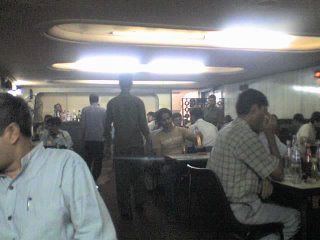 (I must make a film located in Olys...)
(I must make a film located in Olys...) This is new blues. It's derived from black man blues and done by white men but it has a contemporariness which is refreshing. At the same time elements of the familiar are spread across each song letting you indulge in a bit of deja vu. The Wood Brothers album is first and foremost blues in its traditional 12-bar form, and then the tweaks and other style influences, not least being jazz. Oliver's voice has a gravelly tone tending to the nasal but he sings his soul. His guitar playing is prominent but not overwhelming. Chris' acoustic upright bass is contrapuntal in its soft statements which may lack the hard punch and growl of blues but never deviates from its earthy presence in all the songs. Lovely album! "At least when I die young, I'll have chocolate on my tongue". One line from one song, you must listen to the rest.
This is new blues. It's derived from black man blues and done by white men but it has a contemporariness which is refreshing. At the same time elements of the familiar are spread across each song letting you indulge in a bit of deja vu. The Wood Brothers album is first and foremost blues in its traditional 12-bar form, and then the tweaks and other style influences, not least being jazz. Oliver's voice has a gravelly tone tending to the nasal but he sings his soul. His guitar playing is prominent but not overwhelming. Chris' acoustic upright bass is contrapuntal in its soft statements which may lack the hard punch and growl of blues but never deviates from its earthy presence in all the songs. Lovely album! "At least when I die young, I'll have chocolate on my tongue". One line from one song, you must listen to the rest. Elvis Costello, a British musician has been quite a phenomenon in the West since the 80s. Somehow he never was able to make his presence felt among the wide ranging listening that many of us do back here in India. Allen Toussaint was a name that briefly came up in Santana's Moonflower record as the last song 'Toussaint L'Overture'. I have not actually followed either of these musicians but I see that Toussaint is considered "one of America's greatest musical treasures" with almost guru-like attributes. Anyway, this collaboration between these two musicians has resulted in The River In Reverse. It has songs from Allen Toussaint's own catalogue, plus five new ones penned by them both, as well as the title track by Elvis. This is a gumbo of New Orleans and rock'n'roll and some other influences not immediately identifiable from the initial listening. Yet another gem I impulsively bought without any real knowledge!
Elvis Costello, a British musician has been quite a phenomenon in the West since the 80s. Somehow he never was able to make his presence felt among the wide ranging listening that many of us do back here in India. Allen Toussaint was a name that briefly came up in Santana's Moonflower record as the last song 'Toussaint L'Overture'. I have not actually followed either of these musicians but I see that Toussaint is considered "one of America's greatest musical treasures" with almost guru-like attributes. Anyway, this collaboration between these two musicians has resulted in The River In Reverse. It has songs from Allen Toussaint's own catalogue, plus five new ones penned by them both, as well as the title track by Elvis. This is a gumbo of New Orleans and rock'n'roll and some other influences not immediately identifiable from the initial listening. Yet another gem I impulsively bought without any real knowledge!





